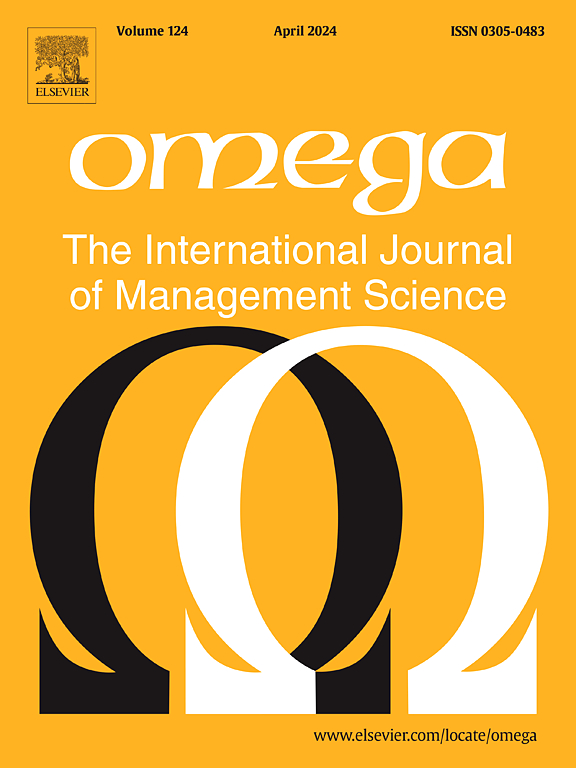Integrating second-order effects in ELECTRE methods with an interval-based approach
IF 7.2
2区 管理学
Q1 MANAGEMENT
Omega-international Journal of Management Science
Pub Date : 2025-05-03
DOI:10.1016/j.omega.2025.103353
引用次数: 0
Abstract
Evolving from earlier versions, the ELECTRE methods achieved their most popular model with the fuzzy outranking relation of ELECTRE III. In more recent papers, the effects of reinforced preference, interacting criteria, and the relative strength of the discordance coalition have enhanced the original ELECTRE III. However, these enhancements were proposed separately. This paper has the merit of combining ELECTRE III with its enhancements in a comprehensive model. Although the extended model is more sophisticated and complex, its application may be necessary to accurately reflect the decision maker’s preferences when at least two of the three modifications to the original ELECTRE III cannot be neglected. Since the comprehensive model is more complex than the original one and may contain numerous parameters that are unfamiliar to decision-makers, its construction may be a challenging cognitive task for them. To alleviate this task and handle imperfect knowledge about model parameters and criteria performance levels, this paper proposes an interval-based approach. Thus, as a result of this paper, the pair Decision Maker–Decision Analyst can opt for one of two models: i) the extended ELECTRE III, where parameters and criteria are real numbers; or ii) the interval-based generalization of ELECTRE III, where parameters and criteria can be interval numbers. Both models combine the effects of reinforced preference, interacting criteria, and the relative strength of the discordance coalition. The interval model is more complex but the direct elicitation of its parameters is easier. The outranking relations provided by both approaches are useful for selection and ranking purposes, as well as multiple criteria ordinal classification. The ordinal classification methods based on these relations fulfill the consistency properties required by the ELECTRE TRI family. The new proposal is illustrated by two examples: the first is a simple ordinal classification problem with real numbers; the second example, with the use of interval numbers, comes from a real-world decision problem, revisiting a case study regarding the assessment of the performance of countries from the Organization for Economic Co-operation and Development (OECD).
利用基于区间的方法整合电子电工方法中的二阶效应
从早期版本演变而来,ELECTRE方法利用ELECTRE III的模糊超级关系实现了最受欢迎的模型。在最近的一些论文中,强化偏好、相互作用标准和不协调联盟的相对强度的影响增强了原始的ELECTRE III。但是,这些增强是单独提出的。本文的优点是将ELECTRE III及其增强功能结合在一个综合模型中。虽然扩展模型更加复杂和复杂,但当对原始ELECTRE III的三个修改中至少有两个不能忽略时,它的应用可能是必要的,以准确反映决策者的偏好。由于综合模型比原始模型更复杂,并且可能包含许多决策者不熟悉的参数,因此它的构建对决策者来说可能是一项具有挑战性的认知任务。为了减轻这一任务,并处理关于模型参数和标准性能水平的不完善知识,本文提出了一种基于区间的方法。因此,根据本文的研究结果,决策者-决策分析师可以选择两种模型中的一种:i)扩展的ELECTRE III模型,其中参数和准则是实数;或ii)基于区间的ELECTRE III概化,其中参数和准则可以是区间数。这两个模型都结合了强化偏好、相互作用标准和不协调联盟的相对强度的影响。区间模型比较复杂,但其参数的直接提取比较容易。这两种方法提供的超排序关系对于选择和排序目的以及多标准有序分类都很有用。基于这些关系的有序分类方法满足了ELECTRE TRI族所要求的一致性。通过两个实例说明了新方法:第一个是一个简单的实数有序分类问题;第二个例子使用了区间数,它来自一个现实世界的决策问题,重新审视了一个关于经济合作与发展组织(OECD)国家绩效评估的案例研究。
本文章由计算机程序翻译,如有差异,请以英文原文为准。
求助全文
约1分钟内获得全文
求助全文
来源期刊

Omega-international Journal of Management Science
管理科学-运筹学与管理科学
CiteScore
13.80
自引率
11.60%
发文量
130
审稿时长
56 days
期刊介绍:
Omega reports on developments in management, including the latest research results and applications. Original contributions and review articles describe the state of the art in specific fields or functions of management, while there are shorter critical assessments of particular management techniques. Other features of the journal are the "Memoranda" section for short communications and "Feedback", a correspondence column. Omega is both stimulating reading and an important source for practising managers, specialists in management services, operational research workers and management scientists, management consultants, academics, students and research personnel throughout the world. The material published is of high quality and relevance, written in a manner which makes it accessible to all of this wide-ranging readership. Preference will be given to papers with implications to the practice of management. Submissions of purely theoretical papers are discouraged. The review of material for publication in the journal reflects this aim.
 求助内容:
求助内容: 应助结果提醒方式:
应助结果提醒方式:


